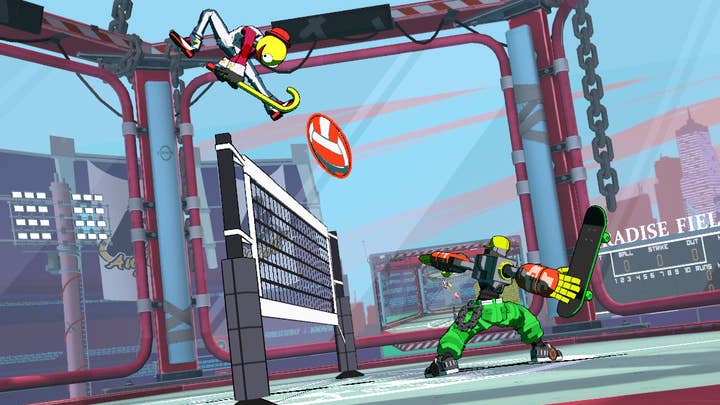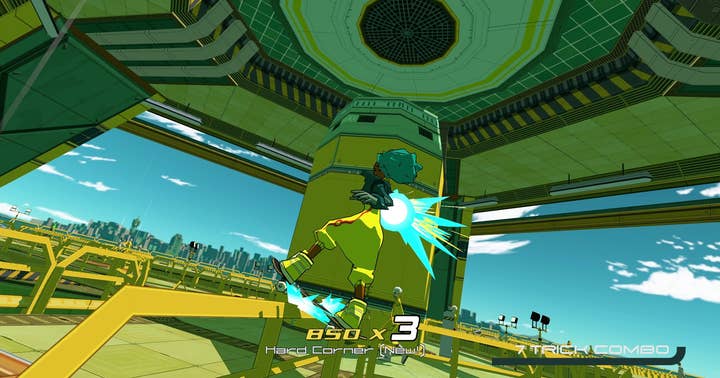Team Reptile: From Megabyte Punch to Bomb Rush Cyberfunk
Founders Dion Koster and Tim Remmers discuss how betting on themselves led to a decade of creative freedom
Sign up for the GI Daily here to get the biggest news straight to your inbox
It would be easy look at Team Reptile's Bomb Rush Cyberfunk and conclude that the stylish skater is the product of a deep affection for Sega's Jet Set Radio. But as game director Dion Koster and managing director Tim Remmers tell GamesIndustry.biz, it's just as much the product of ten years of creative and business decisions at the studio.

Shortly after Team Reptile was founded, its first foray into the games industry was 2013's Megabyte Punch, a 3D fighter for PC. Eventually, it would get a console for the Switch seven years later.
Remmers says that the biggest takeaway then was to temper ambitions with its current toolset and skills.
"When you start out as a game developer, you always want to create the perfect game with all features possible as your first product. However, this hardly turns out well," he explains.
"When you start out as a game developer, you always want to create the perfect game with all features possible as your first product"Tim Remmers
Megabyte Punch, as its name implies, has fighting game elements at its heart. However, the studio built the game surrounding that heart into a side-scrolling adventure title. Remmers says, "This wasn't the worst, but it did water down the concept's core. [It] did extend development time while not making the game better."
Perhaps as a result, the title didn't immediately click with audiences.
Koster says, "Megabyte Punch is our only title that wasn't an overnight success. Although it was received very positively, it did become successful later on. It showed us the reality of appeal and visibility and made us appreciate the long-term view more."
It was self-published, but the initial struggles it faced did not dissuade them from sticking with self-publishing for future games.
"At first, we were able to make games with shoestring budgets due to living with our parents. We were taking a bet on ourselves. At the time, we could see many small teams getting stuck in very bad deals with publishers. So we skipped on that," the game director explains.

The decision to stick with self-publishing paid off with the company's 2014 projectile-focused fighting game Lethal League. Team Reptile's second studio release and its follow-up in 2017, Lethal League Blaze, serves as a precursor to Bomb Rush Cyberfunk. It features a colorful cast and soundtrack inspired by Koster's long-time interest in street culture.
Koster says, "When we had a hit with Lethal League, we saw that even though it was underground because there was no big marketing push behind it, we could make dope hard-hitting things regardless. We had more fun creatively, didn't need to explain ourselves, and could live off it. Which has always been the goal."
"We had more fun creatively, didn't need to explain ourselves, and could live off it. Which has always been the goal"Dion Koster
Remmers notes that while Team Reptile has maintained its decision to self-publish, it receives publishing offers often. The studio has continued to decline them.
"We like to be in control over all the things we do. On top of that, we have been operating independently since the beginning. Revenue from previous games always provided funding for the next. This way, we have been able to build a rock-solid foundation for the company," he says. "Also, when working on creative products like video games, it's important for us that no external forces affect the direction of the game. There is no financial stress of funding or loans and no obligations to publishers. This has been working out great for us the past 12 years."
Before the release of Bomb Rush Cyberfunk, Team Reptile's titles focused on fighting. Remmers explains that Megabyte Punch was a byproduct of their interest at the time. It would provide the studio with ideas for its following projects.
"When we started out, we never set out to create fighting-type games, but it organically flowed into that direction. With Bomb Rush Cyberfunk, we've completely drifted away from the fighting genre. Megabyte Punch was influenced by Smash Bros., a game we were playing a lot at the time," Remmers explains.
"Lethal League was originally based on a simple (rocket-reflecting) mechanic from Megabyte Punch. The prototype that was created within two weeks was picked up by the Ultimate Fighting Game Tournament and was a hit during side tournaments of fighting game events. This led us to make a full-fledged version of Lethal League with the fighting game community in the back of our minds."
"It showed me a medium to channel my life expression rather than being a sole inspiration"Dion Koster
The idea to create a game like Bomb Rush Cyberfunk was something that Koster had in mind before establishing the Team Reptile studio.
"I was into hip-hop through b-boying and also skating before really making games. Around the time I started messing with Game Maker, I learned of Jet Set Radio Future," Koster says. "This game blew my mind on how the stuff that I was doing could be projected into the future. So, it showed me a medium to channel my life expression rather than being a sole inspiration."
Regarding the marketing of Bomb Rush Cyberfunk, Remmers says that the studio made a conscious effort to present it to people who had similar interests in the game's influences. "We want to get the game in front of people that are into hip-hop, street culture, and everything surrounding it since there is hardly any genuine representation of this in video games," he says.
Koster added that promoting and self-publishing the game wasn't necessarily challenging.
"In terms of promoting honestly, this was the most dreamlike situation. We just put everything we like on social media and get huge numbers. Yes, porting and submitting to stores ourselves is a long and tedious hassle. But it just takes time," he says.
Despite it being Team Reptile's first game away from the fighting genre, Remmers suggests Bomb Rush Cyberfunk development was in some ways easier to make than its previous efforts.
Remmers says, "It wasn't that challenging to go from a fighter to a skating game, to be honest. I could argue Lethal League was more challenging since this was online and was bound to strict gameplay rules. Developing Bomb Rush Cyberfunk, we had more freedom. What was more challenging, though, was the bigger team size and working with team members that are working from home in different timezones."
He continues, "While still being hands-on, Dion and I had to pick up more directing roles due to the size of the project. There are a lot more dependencies in terms of developing this game. Keeping all different disciplines in sync was challenging sometimes. We also felt we were touching the limits of Unity in terms of multiple developers working on the same scenes.
"Another example was working with Probuilder, which has been both a curse and a blessing. With this built-in tool, we could work on bigger city environments more freely. However, this tool was not built for this purpose and caused a lot of performance issues."

The game director notes that the most surprising idea that was created for Bomb Rush Cyberfunk was its inclusion of multiple methods of travel/trick styles, which he attributes to a suggestion from technical animator Niels Schaap.
"[Back] when the game did not have any skating or BMX yet, our technical animator Niels Schaap said to me one Friday, 'How about we secretly work through the weekend and add a BMX to the game?'" Koster explains. "We had entertained the thought before, but always with an unserious tone of how interesting it would be. I liked the challenge, so I joined him and surprised the rest of the team with it on Monday. At that point, the floodgates had opened, and we were adding skateboarding and inline skates not long after."
Developing the skating game was a three-and-a-half-year endeavor, Remmers explains. The team working on the title was small. However, he notes it was made possible with the work of many individuals.
"We have been working with a wide variety of freelancers and feature tons of designers, dancers, musical artists, and graffiti artists"Tim Remmers
"Around 12 people worked on the game consistently. However, we have been working with a wide variety of freelancers and feature tons of designers, dancers, musical artists, and graffiti artists," says Remmers.
While Bomb Rush Cyberfunk represents ten years of Team Reptile's creative and business expertise, its game director acknowledges that something similar could have been possible sooner.
Koster explains, "In a reduced form, it could have happened right after the first Lethal League, but it would have been a very different game. Instead, I like how my vision has evolved over the years, but either path would have led to the inevitability of making more street adventure games anyway."
Sign up for the GI Daily here to get the biggest news straight to your inbox

